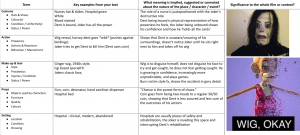| Significant Event in Politics / Society | Details | Relevance to The Dark Knight |
| Al Gore won the popular vote, but Bush won the electoral votes (Bush v. Gore controversy) | Bush ran instead of Clinton. Began a missile program and started to drill in Antartica. Cut taxes in an attempt to stimulate the economy. | In theory people should have gained a larger amount of proportional income, however, class inequalities still existed on a large scale |
| 9/11, brought America together (through patriotism) and the ‘war on terror’ | Redefined ‘freedom’ in the US.
Bush doctrine – go to war with terrorists (started an ‘with us or with them’ ideology) |
General public has a harsher view on terrorists / anyone who threatens the American view of the status quo |
| ‘Axis of evil’, countries that supposedly harboured terrorists | More animosity / less care towards other nations | Batman (and many of the viewers) had no qualms breaking international law to bring Lau back to the US, to be tried on American terms. |
| USA PATRIOT Act – Uniting and Strengthening America by Providing Appropriate Tools Required to Intercept and Obstruct Terrorism | USA Patriot Act allowed people to be spied on and detained and introduced ‘Advanced Interrogation techniques’ | Batman uses both ‘Advanced Interrogation techniques’ and a sophisticated surveillance system, jarring to watch and worse when you realise they are both things the government can legally do in the name of ‘freedom’. |
| Hurricane Katrina exposed inequalities | Showed class divisions | Gotham is home to both billionaires and the impoverished, class inequality is the most striking here (Gotham = microcosm of US?) |
CrashCourse. (2014). Terrorism, War, and Bush 43: Crash Course US History #46. [Online Video]. 30 January 2014. Available from: https://www.youtube.com/. [Accessed: 11 December 2020].
Turner, P., 2020. Dark Knight, Dark Ideas: The Ideology of Nolan’s Batman Trilogy. Media Magazine, [Online]. Available at: https://www.englishandmedia.co.uk/media-magazine/articles/16916 [Accessed 11 December 2020].

